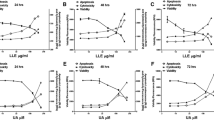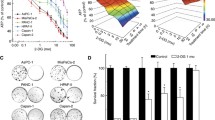Abstract
The rationale of this dose matching/dose escalating study was to compare a panel of flavonoids—luteolin, resveratrol, and quercetin—against the metabolite flux-controlling properties of a synthetic targeted fatty acid synthase inhibitor drug C75 on multiple macromolecule synthesis pathways in pancreatic tumor cells using [1,2-13C2]-d-glucose as the single precursor metabolic tracer. MIA PaCa-2 pancreatic adenocarcinoma cells were cultured for 48 h in the presence of 0.1% DMSO (control), or 50 or 100 μM of each test compound, while intracellular glycogen, RNA ribose, palmitate and cholesterol as well as extra cellular 13CO2, lactate and glutamate production patterns were measured using gas chromatography/mass spectrometry (GC/MS) and stable isotope-based dynamic metabolic profiling (SiDMAP). The use of 50% [1,2-13C2]-d-glucose as tracer resulted in an average of 24 excess 13CO2 molecules for each 1,000 CO2 molecule in the culture media, which was decreased by 29 and 33% (P < 0.01) with 100 μM C75 and luteolin treatments, respectively. Extracellular tracer glucose-derived 13C-labeled lactate fractions (Σm) were between 45.52 and 47.49% in all cultures with a molar ratio of 2.47% M + 1/Σm lactate produced indirectly by direct oxidation of glucose in the pentose cycle in control cultures; treatment with 100 μM C75 and luteolin decreased this figure to 1.80 and 1.67%. The tracer glucose-derived 13C labeled fraction (Σm) of ribonucleotide ribose was 34.73% in controls, which was decreased to 20.58 and 8.45% with C75, 16.15 and 6.86% with luteolin, 27.66 and 19.25% with resveratrol, and 30.09 and 25.67% with quercetin, respectively. Luteolin effectively decreased nucleotide precursor synthesis pentose cycle flux primarily via the oxidative branch, where we observed a 41.74% flux (M + 1/Σm) in control cells, in comparison with only a 37.19%, 32.74%, or a 26.57%, 25.47% M + 1/Σm flux (P < 0.001) after 50 or 100 μM C75 or luteolin treatment. Intracellular de novo fatty acid palmitate (C16:0) synthesis was severely and equally blocked by C75 and luteolin treatments indicated by the 5.49% (control), 2.29 or 2.47% (C75) and 2.21 or 2.73% (luteolin) tracer glucose-derived 13C-labeled fractions, respectively. On the other hand there was a significant 192 and 159% (P < 0.001), and a 103 and 117% (P < 0.01) increase in tracer glucose-derived cholesterol after C75 or luteolin treatment. Only resveratrol and quercetin at 100 μM inhibited tracer glucose-derived glycogen labeling (Σm) and turnover by 34.8 and 23.8%, respectively. The flavonoid luteolin possesses equal efficacy to inhibit fatty acid palmitate de novo synthesis as well as nucleotide RNA ribose turnover via the oxidative branch of the pentose cycle in comparison with the targeted fatty acid synthase inhibitor synthetic compound C75. Luteolin is also effective in stringently controlling glucose entry and anaplerosis in the TCA cycle, while it promotes less glucose flux towards cholesterol synthesis than that of C75. In contrast, quercetin and resveratrol inhibit glycogen synthesis and turnover as their underlying mechanism of controlling tumor cell proliferation. Therefore the flavonoid luteolin controls fatty and nucleic acid syntheses as well as energy production with pharmacological strength, which can be explored as a non-toxic natural treatment modality for pancreatic cancer.










Similar content being viewed by others
References
Alo, P. L., Amini, M., Piro, F., Pizzuti, L., Sebastiani, V., Botti, C., et al. (2007). Immunohistochemical expression and prognostic significance of fatty acid synthase in pancreatic carcinoma. Anticancer Research, 27(4B), 2523–2527.
Alo, P. L., Visca, P., Marci, A., Mangoni, A., Botti, C., & Di, T. U. (1996). Expression of fatty acid synthase (FAS) as a predictor of recurrence in stage I breast carcinoma patients. Cancer, 77(3), 474–482.
Boros, L. G., Lerner, M. R., Morgan, D. L., Taylor, S. L., Smith, B. J., Postier, R. G., et al. (2005). [1,2-13C2]-d-glucose profiles of the serum, liver, pancreas, and DMBA-induced pancreatic tumors of rats. Pancreas, 31(4), 337–343.
Brusselmans, K., Vrolix, R., Verhoeven, G., & Swinnen, J. V. (2005). Induction of cancer cell apoptosis by flavonoids is associated with their ability to inhibit fatty acid synthase activity. Journal of Biological Chemistry, 280(7), 5636–5645.
Crick, D. C., & Carroll, K. K. (1987). Extraction and quantitation of total cholesterol, dolichol and dolichyl phosphate from mammalian liver. Lipids, 22(12), 1045–1048.
Go, V. L., Nguyen, C. T., Harris, D. M., & Lee, W. N. (2005). Nutrient–gene interaction: Metabolic genotype–phenotype relationship. Journal of Nutrition, 135(12 Suppl), 3016S–3020S.
Harris, D. M., Besselink, E., Henning, S. M., Go, V. L., & Heber, D. (2005). Phytoestrogens induce differential estrogen receptor alpha- or beta-mediated responses in transfected breast cancer cells. Experimental Biology and Medicine (Maywood), 230(8), 558–568.
Harris, D. M., & Go, V. L. (2006). How dietary components protect from cancer. In A. B. Awad & P. G. Bradford (Eds.), Nutrition and cancer prevention (pp. 27–58). Boca Raton, FL: CRC Press.
Hussein, D., & Mo, H. (2009). d-Delta-tocotrienol-mediated suppression of the proliferation of human PANC-1, MIA PaCa-2, and BxPC-3 pancreatic carcinoma cells. Pancreas, 38(4), e124–e136.
Jensen, V., Ladekarl, M., Holm-Nielsen, P., Melsen, F., & Soerensen, F. B. (1995). The prognostic value of oncogenic antigen 519 (OA-519) expression and proliferative activity detected by antibody MIB-1 in node-negative breast cancer. Journal of Pathology, 176(4), 343–352.
Kuhajda, F. P. (2000). Fatty-acid synthase and human cancer: New perspectives on its role in tumor biology. Nutrition, 16(3), 202–208.
Kuhajda, F. P. (2006). Fatty acid synthase and cancer: New application of an old pathway. Cancer Research, 66(12), 5977–5980.
Kuhajda, F. P., Jenner, K., Wood, F. D., Hennigar, R. A., Jacobs, L. B., Dick, J. D., et al. (1994). Fatty acid synthesis: A potential selective target for antineoplastic therapy. Proceedings of the National Academy of Sciences of the United States of America, 91(14), 6379–6383.
Kuhajda, F. P., Pizer, E. S., Li, J. N., Mani, N. S., Frehywot, G. L., & Townsend, C. A. (2000). Synthesis and antitumor activity of an inhibitor of fatty acid synthase. Proceedings of the National Academy of Sciences of the United States of America, 97(7), 3450–3454.
Lee, W. N. (1996). Stable isotopes and mass isotopomer study of fatty acid and cholesterol synthesis. A review of the MIDA approach. Advances in Experimental Medicine and Biology, 399, 95–114.
Lee, W. N., Boros, L. G., Puigjaner, J., Bassilian, S., Lim, S., & Cascante, M. (1998a). Mass isotopomer study of the nonoxidative pathways of the pentose cycle with [1,2-13C2]glucose. American Journal of Physiology, 274(5 Pt 1), E843–E851.
Lee, W. N., Guo, P., Lim, S., Bassilian, S., Lee, S. T., Boren, J., et al. (2004). Metabolic sensitivity of pancreatic tumour cell apoptosis to glycogen phosphorylase inhibitor treatment. British Journal of Cancer, 91(12), 2094–2100.
Lee, W. N., Lim, S., Bassilian, S., Bergner, E. A., & Edmond, J. (1998b). Fatty acid cycling in human hepatoma cells and the effects of troglitazone. Journal of Biological Chemistry, 273(33), 20929–20934.
Lin, Y., Shi, R., Wang, X., & Shen, H. M. (2008). Luteolin, a flavonoid with potential for cancer prevention and therapy. Current Cancer Drug Targets, 8(7), 634–646.
Manach, C., Scalbert, A., Morand, C., Remesy, C., & Jimenez, L. (2004). Polyphenols: Food sources and bioavailability. American Journal of Clinical Nutrition, 79(5), 727–747.
Metallo, C. M., Walther, J. L., & Stephanopoulos, G. (2009). Evaluation of 13C isotopic tracers for metabolic flux analysis in mammalian cells. Journal of Biotechnology, 144(3), 167–174.
Pizer, E. S., Jackisch, C., Wood, F. D., Pasternack, G. R., Davidson, N. E., & Kuhajda, F. P. (1996). Inhibition of fatty acid synthesis induces programmed cell death in human breast cancer cells. Cancer Research, 56(12), 2745–2747.
Pizer, E. S., Pflug, B. R., Bova, G. S., Han, W. F., Udan, M. S., & Nelson, J. B. (2001). Increased fatty acid synthase as a therapeutic target in androgen-independent prostate cancer progression. Prostate, 47(2), 102–110.
Pizer, E. S., Thupari, J., Han, W. F., Pinn, M. L., Chrest, F. J., Frehywot, G. L., et al. (2000). Malonyl-coenzyme-A is a potential mediator of cytotoxicity induced by fatty-acid synthase inhibition in human breast cancer cells and xenografts. Cancer Research, 60(2), 213–218.
Powell, N., Smith, K., & Fiander, A. (2006). Recovery of human papillomavirus nucleic acids from liquid-based cytology media. Journal of Virological Methods, 137(1), 58–62.
Sarkar, F. H., Li, Y., Wang, Z., & Kong, D. (2009). Cellular signaling perturbation by natural products. Cellular Signalling, 21(11), 1541–1547.
Swinnen, J. V., Brusselmans, K., & Verhoeven, G. (2006). Increased lipogenesis in cancer cells: New players, novel targets. Current Opinion in Clinical Nutrition & Metabolic Care, 9(4), 358–365.
Tian, W. X. (2006). Inhibition of fatty acid synthase by polyphenols. Current Medicinal Chemistry, 13(8), 967–977.
Witkiewicz, A. K., Nguyen, K. H., Dasgupta, A., Kennedy, E. P., Yeo, C. J., Lisanti, M. P., et al. (2008). Co-expression of fatty acid synthase and caveolin-1 in pancreatic ductal adenocarcinoma: Implications for tumor progression and clinical outcome. Cell Cycle, 7(19), 3021–3025.
Yoo, H., Antoniewicz, M. R., Stephanopoulos, G., & Kelleher, J. K. (2008). Quantifying reductive carboxylation flux of glutamine to lipid in a brown adipocyte cell line. Journal of Biological Chemistry, 283(30), 20621–20627.
Zhou, W., Simpson, P. J., McFadden, J. M., Townsend, C. A., Medghalchi, S. M., Vadlamudi, A., et al. (2003). Fatty acid synthase inhibition triggers apoptosis during S phase in human cancer cells. Cancer Research, 63(21), 7330–7337.
Acknowledgments
This work was supported by the UCLA Center for Excellence in Pancreatic Research (1P01AT003960-01A1 VLW Go), by PHS M01-RR00425 of the General Clinical Research Unit, and by the Hirshberg Foundation for Pancreatic Cancer Research.
Author information
Authors and Affiliations
Corresponding author
Rights and permissions
About this article
Cite this article
Harris, D.M., Li, L., Chen, M. et al. Diverse mechanisms of growth inhibition by luteolin, resveratrol, and quercetin in MIA PaCa-2 cells: a comparative glucose tracer study with the fatty acid synthase inhibitor C75. Metabolomics 8, 201–210 (2012). https://doi.org/10.1007/s11306-011-0300-9
Received:
Accepted:
Published:
Issue Date:
DOI: https://doi.org/10.1007/s11306-011-0300-9




